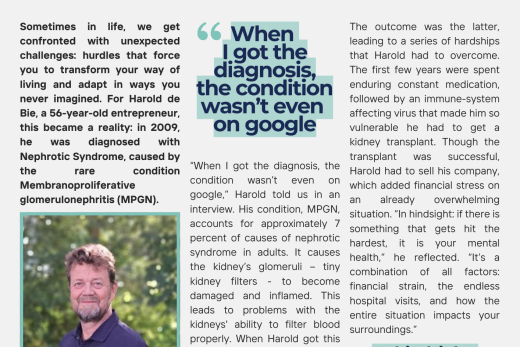30/03/2025
Navigating Life with Kidney Disease
Sometimes in life, we get confronted with unexpected challenges: hurdles that force you to transform your way of living and adapt in ways you never imagined. For Harold van de Bie, a 56 years old former entrepreneur, this became a reality: in 2009, he was diagnosed with Nephrotic Syndrome, caused by the rare condition Membranoproliferative glomerulonephritis (MPGN).
“When I got the diagnosis, the condition wasn’t even on google,” Harold told us in an interview. His condition, MPGN, accounts for approximately 7 percent of causes of nephrotic syndrome in adults. It causes the kidney’s glomeruli – tiny kidney filters - to become damaged and inflamed. This leads to problems with the kidneys' ability to filter blood properly. When Harold got this diagnosis, the doctors outlined three possibilities: the condition might clear up on its own, become life-threatening, or lead to a future where he’d depend on dialysis or a kidney transplant.
The outcome was the latter, leading to a series of hardships that Harold had to overcome. The first few years were spent enduring constant medication, followed by an immune-system affecting virus that made him so vulnerable he had to get a kidney transplant. Though the transplant was successful, Harold had to sell his company, which added financial stress on an already overwhelming situation. “In hindsight: if there is something that gets hit the hardest, it is your mental health,” he reflected. “It’s a combination of all factors: financial strain, the endless hospital visits, and how the entire situation impacts your surroundings.”
How Harold views the idea of continuous monitoring with biosensors? While it might feel like a concept for the future, Harold sees how it could be valuable for maintaining his health. He explains that while salt is harmful to kidney function, completely avoiding it isn't the solution either. "I had to go salt-free for a while, but I’ve learned that you need a certain amount of salt for your body to function properly,” he says. With a wearable biosensor, he could track how salt affects his kidney condition in real-time, allowing him and other kidney patients to find the right balance in diet.
Harold is one of the millions of people suffering from kidney disease. Over 2 million people worldwide currently receive treatment with dialysis or a kidney transplant to stay alive, and this number represents only a small fraction of the people who can benefit from better care. That's why the international student teams in SensUs are developing continuous biosensors that may help patients to take control of their health. Wearable sensors that monitor critical biomarkers could give real time data, reduce guesswork in diet and treatment, and hopefully provide patients with peace of mind and a better quality of life.

Facebook
YouTube
LinkedIn
Instagram